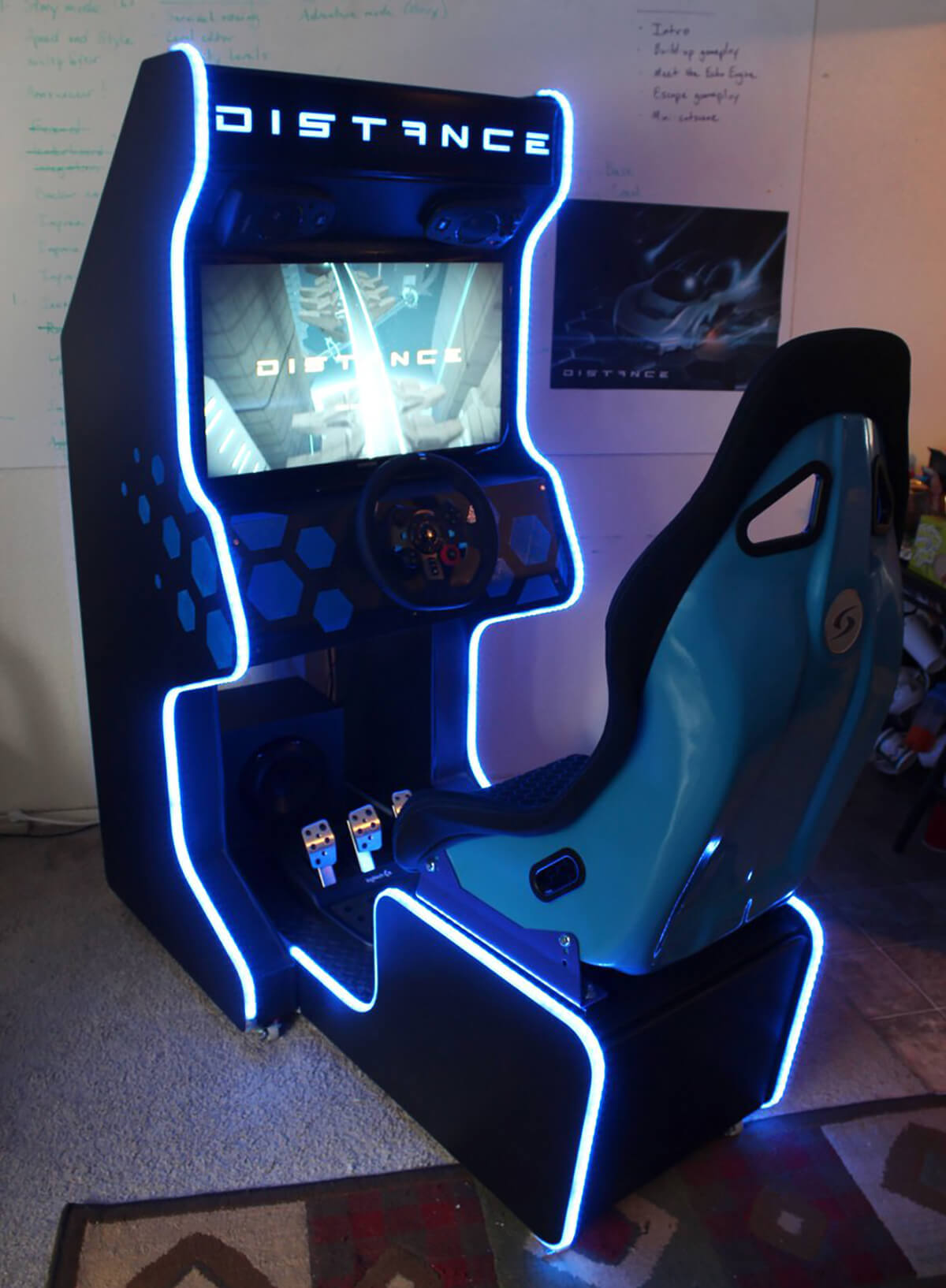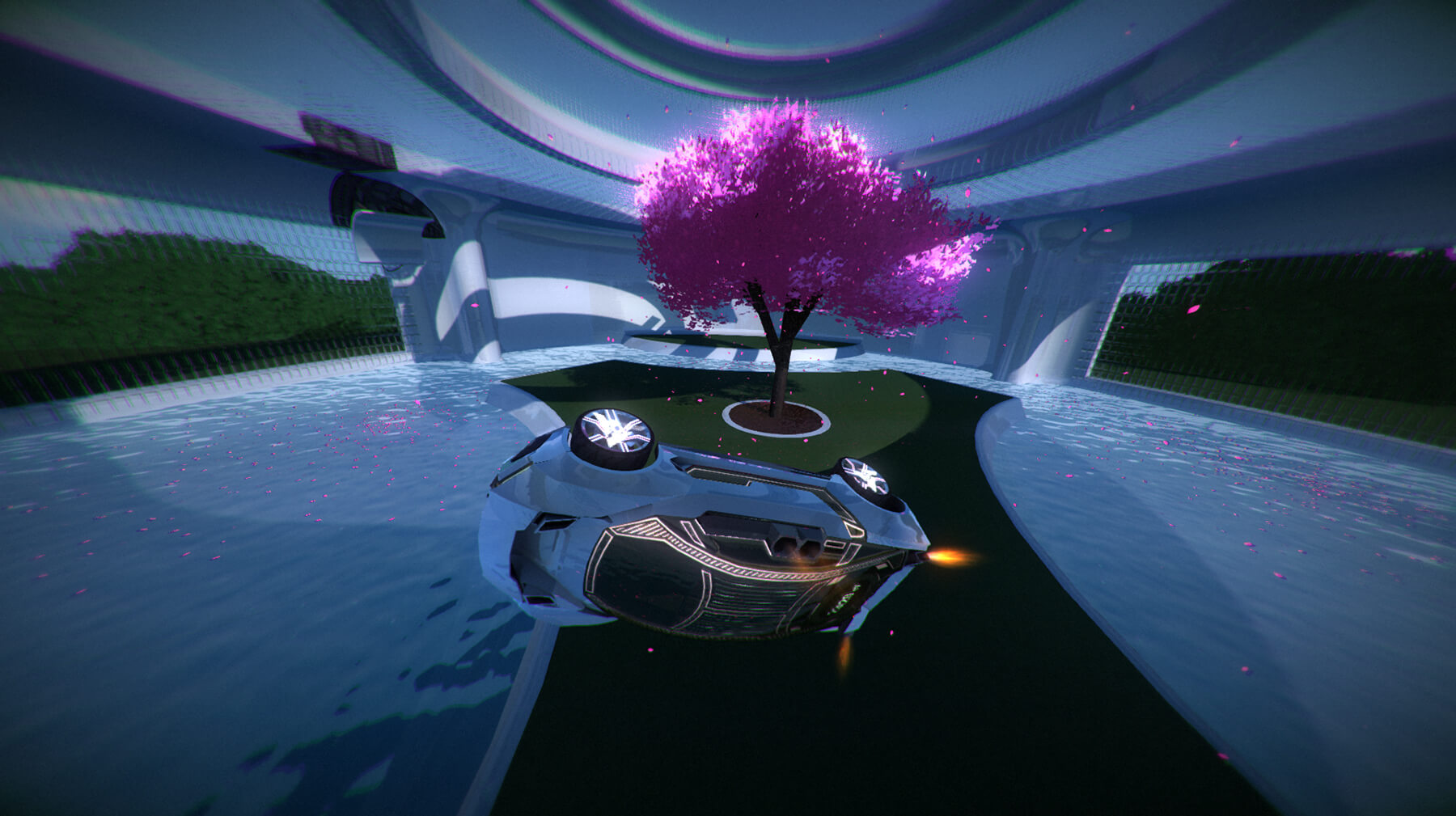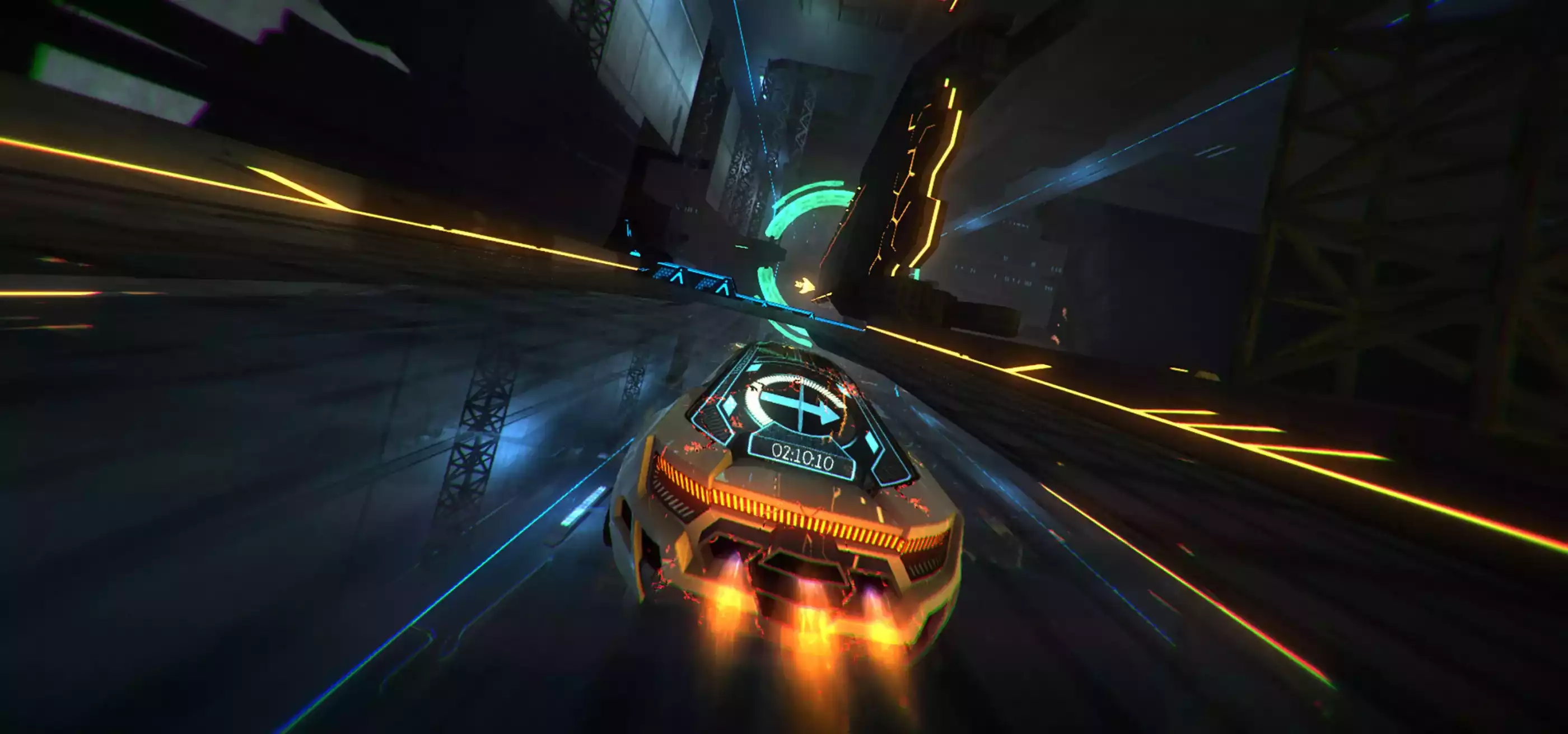Some video games can be in development for years before they’re officially released, and—much to the developers’ dismay—there’s no guarantee that they will be embraced by the target audience when they do. Fortunately, for the co-founders of Refract Studios, the six years they’ve put into their “atmospheric racing platformer” game Distance has already cleared that hurdle thanks to a strong introduction on Steam Early Access.
At least part of the game’s popularity can be attributed to the fact that Distance, like its spiritual predecessor, the DigiPen student game Nitronic Rush, can’t necessarily be pinned down to one specific genre.

“One of the biggest things we hear at conventions is, ‘I don’t really like racing games, but this is amazing and I really want to play this more,’” says Jordan Hemenway (2012, BS in Computer Science in Real-Time Interactive Simulation), Refract’s co-founder and creative director. “That’s why we’ve pivoted more towards saying it has platformer elements, because at the end of the day, it is a racing platformer. It is more than just the normal racing game.”
This melding of gameplay genres has proven to be a winner, with thousands of unique players accessing the game each week. That’s why the excitement around the September 2018 full release of Distance on PC is less about whether the game will succeed—it already has—and more about the fulfillment of a promise and new promises for the future.

Five years after their Kickstarter campaign wrapped up, Hemenway and his fellow Refract co-founders—2012 DigiPen graduates Jason Nollan and Kyle Holdwick—are not only preparing to launch the new version of the game on Steam; they are also hard at work packing and shipping out Distance posters and t-shirts to many of the 4,174 supporters who helped them reach and exceed their original funding goal.
The crown jewels of these rewards, however, are the two handmade Distance arcade cabinets. Going to the two campaign backers who pledged at least $10,000, the cabinets were designed and fabricated largely by just a single person, Nollan. Along with classic arcade-style steering controls and a racing seat, the cabinets also feature brilliant-blue lights running along the edges that bathe onlookers in a neon glow.
Something Blue, Something New
While the team’s pre-launch dash has been dominated by reward fulfillment, most of the time since the Kickstarter campaign has been spent working on the game itself. Distance was never intended to be a simple remake of Nitronic Rush; it was also going to have a much deeper experience for gamers to engage with.
“There’s a general ‘arcade-y’ spirit that was in Nitronic that we wanted to retain. But at the same time, we also wanted to be a bit more mature and more complex,” says Hemenway. “Most people are expecting Wipeout or some other futuristic racing game thinking that’s what futuristic racing games are. And we’re like, no, they don’t all have to be like that.”
Since the Early Access launch on Steam, one of the most important developments for the game has been the level-editing tool. An accessible map-maker that gives players the chance to build their own Distance levels, this feature has given the game a huge well of replayability, with over 2,500 user-made maps now available to the community. Multiplayer functionality was also a new addition to the Nitronic Rush formula and likely contributed to its spread among players looking to compete against friends and others around the world.
With this full launch of the game (officially dubbed Distance v1.0), the major new feature is a mysterious single-player narrative experience. While both Nitronic Rush and Distance have always teased an underlying story behind their alluring neon-noir settings, this is the first time the creators have seeded a full narrative that unfolds as players make their way deeper into the game.
“From the very beginning, we wanted to make the story a focus, so that was a big change,” says Hemenway. “I’d say the thing I’m proudest of is probably the Adventure Campaign, which is a narrative that fuses a lot of different genres together, including sci-fi and horror elements. It’s something that’s gone through so many iterations. It’s kind of been my baby. It’s been a lot of people’s baby.”
Though Hemenway says that the story itself is difficult to explain without experiencing it firsthand, it begins with your vehicle being dropped on the outskirts of a space station in Earth’s orbit. Eventually, you must make your way into the heart of a deadly, futuristic city to address a problem that reveals itself as you progress.
Breaking the Game (and Keeping It Alive)
While the $160,000 raised in the Kickstarter campaign was a great success for Refract, the team knew that in game development terms, even that amount of funding could be burned through rapidly. Ultimately, what sustained development on Distance was the decision to make the game available on Steam Early Access.
“Instead of the traditional publisher-investor route, where we ask for a huge chunk of money and hire a bunch of people, we had to scrape together a bunch of people from the money we got from Kickstarter,” said Hemenway. “It was a substantial amount of money, but after six years, we kind of had to be clever about using it. So Early Access worked in our favor that way, where we were able to continue development with the bit of income that came in from that.”
After nearly 150,000 PC downloads of the Distance beta, Refract had the resources to continue development on the game. As it turned out, the players’ support was more than just monetary, and as the game caught on, a dedicated community coalesced around the game.
Speedrunners, for instance, were attracted to the game’s sprawling geography. Thanks to the game’s flying mechanics and parkour controls, creative and skilled players have the ability to fling their vehicles through vast, open spaces in the hopes of saving a few precious seconds. Other players discovered unexpected glitches and exploits throughout the levels, which contributed even more to shorter completion times.

“I’m sure for some people, half the fun for them is the exploit,” says Hemenway. “They’re thinking, ‘They didn’t want me to go here, so I’m going to go here.’ And while we have to fix those exploits, it doesn’t really bother me, because they’re still having fun. They’re still engaging with the game.”
Meanwhile, creative modders and designers were able to use the Distancelevel-editing tool to build intricate and breathtaking maps for other players to enjoy. The highly customizable tools give mapmakers the ability to create not only unique courses, but wild aesthetic styles as well, some of them far different from the look and feel of the base game.
Both the speedrunning and mapmaking communities have even come together for the occasional tournament, called Survive the Editor.
“Right now, leading up to the launch, we have Survive the Editor 2, which is essentially a fusion of an editor competition and a tournament,” says Hemenway. “We have an event streamed on Saturday where community members create, for instance, a sprint map or something. The following week, we have a tournament using the maps supplied in the competition. … People created really crazy maps that are still blowing my mind.”
With each new feature, players found themselves investing in the continued future of the game. This turned out to be especially important for the development of v1.0 when it came to bringing additional contributors onto the team. The player community had become a perfect incubator for just those kinds of experts.
“Not only are we including other people’s levels in v1.0, but we actually hired three people who were in our community making levels that were so incredible that we asked them to help us make Adventure Mode,” Hemenway says. “One of the coolest things is that [none of them] had any industry experience. They did not have any baggage in that area. They just came in saying, ‘I like Distance, I like working in level editor, and I like pushing the boundaries,’ and all of those things worked really well to help push our project forward.”
As Hemenway, Nollan, and Holdwick were all primarily programmers themselves, they also decided early on to reach out to several DigiPen alumni and former classmates who have contributed level designs, art, and music to Distance over the years.
“Eddie Peters and Laura Borgen have been working with us since the Kickstarter and have been our primary artists throughout the project. They’ve also done quite a bit of level design work,” Hemenway says. “Chin Fong helped with concepts before the Kickstarter and did a bit of environment art afterwards. Andrew Nollan worked to port Distance to PS4, and also did quite a bit work with VR and the level editor. M.J. Quigley has been helping us right at the end to create additional music for our ‘Lost to Echoes’ campaign.”
As the project prepares to meet its next big milestone, Hemenway admits to looking forward to life after v1.0, despite understanding that the title itself implies even more iterations to come.
“There is excitement about other projects and other ideas, and we have to tell ourselves, focus on the thing at hand,” says Hemenway. “The official focus, for sure, is to hit 1.0, do updates, respond to feedback, consider potential new content, and then launch the PS4 version. That puts us out easily six months. So I know Distance is going to be in my life for a little while longer.”
Distance v1.0 is available today on PC, Mac, and Linux.
